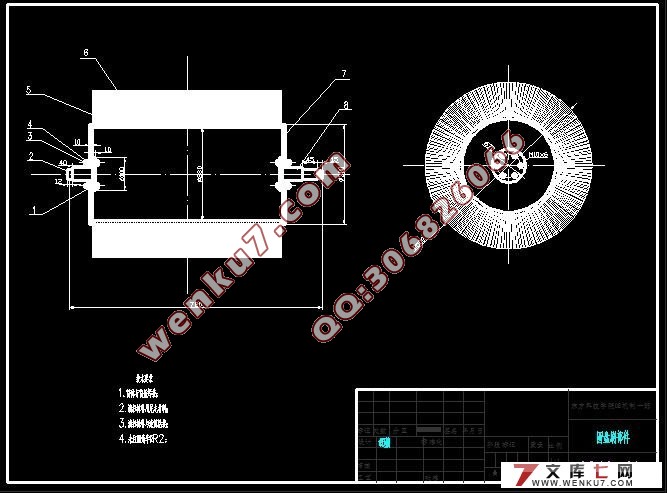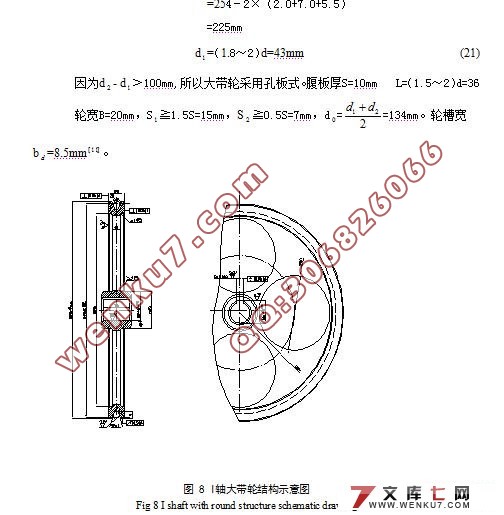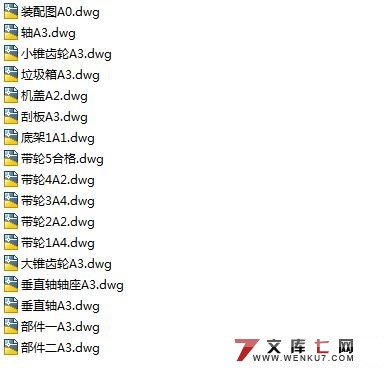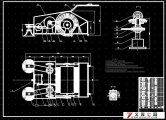自动清扫机的设计
来源:wenku7.com 资料编号:WK74152 资料等级:★★★★★ %E8%B5%84%E6%96%99%E7%BC%96%E5%8F%B7%EF%BC%9AWK74152
以下是资料介绍,如需要完整的请充值下载。
1.无需注册登录,支付后按照提示操作即可获取该资料.
2.资料以网页介绍的为准,下载后不会有水印.资料仅供学习参考之用. 密 保 惠 帮助
资料介绍
自动清扫机的设计(毕业设计说明书14000字,cad图纸17张)
摘要:本文所设计的是用于走廊清扫的清扫机。能源装置通过传动系统将运动传给两侧的盘形刷,使其分别作顺时针和逆时针转动,将两侧的垃圾扫到中间,传给中间的滚刷。然后,再由滚刷将垃圾扫入垃圾箱内实现清扫功能。此设备属中小型清扫工具,可以对各种大小的垃圾进行清理,两侧的清扫刷可方便的清扫墙角及靠近障碍物的地方。
本课题研究中,通过查阅搜集大量资料,对不同清扫设备进行分析对比最终确定出一种较为理想的走廊清扫机的设计方案,然后根据已定方案进行了具体结构的设计计算,并使该设备的结构更加紧凑可靠。确定出各个机构零部件的尺寸及型号后,并对其进行了校核以保证其能够满足设计要求。由于该设备的零部件相对比较普通易于制造,因此该设备的制造成本较低,是一种较为理想的经济实用的走廊清扫工具。
关键词:清扫机;盘形刷;滚刷;制造成本
THE DESIGN OF AUTOMATIC CLEANING MACHINE
Abstract:This article is designed to be used for cleaning cleaning machine in the corridor. Movement of energy transmission system by the appliance will pass on either side of the disc-shaped brush, make it clockwise and counter clockwise, respectively, on either side of the litter swept to the Center, passed on to the middle of the roller brush. Then, by brush to sweep the junk into the litter box cleaning function within. This device is small and medium sized cleaning tools, you can to clean up the garbage of various sizes, on either side of the brush makes cleaning easy for cleaning corners and places close to the obstacle.
In this research, by looking up the collection of large amounts of data, for different cleaning device for analysis and comparison in the corridor finalized a better cleaner design, and according to the specific structure of the programme design, structure and make the device more compact and reliable. After determining the size of various body parts and models, and check to ensure that it can meet the design requirements. Because the parts are relatively general ease of manufacture of the equipment, so the equipment lower manufacturing cost, economical corridor is an ideal tool for cleaning.
Key words: Sweeper; Disc brushes; Rolls brushes; Production cost
设计主要内容
本课题要求设计出的走廊清扫机能完成普通清扫的功能。完成走廊清扫机的方案设计,以及结构组成,并对走廊清扫机结构进行受力计算,使其结构布局和受力更加合理。
其主要设计内容为:
(1) 进行原理的分析及方案的比较
(2) 进行总体结构设计
(3) 进行传动部分设计
(4) 进行执行部分设计
(5) 进行必要的设计计算(含动力参数、运动学分析、刚度计算、强度计算等)
1.3.2 设计工作基本要求
(1)完成至少3张A0图纸
(2)完成约1.5万字的设计说明书
(3)查阅参考文献20篇以上
(4)图纸及说明书符合规范要求并提交电子档




目 录
摘要••••••••••••••••••••••••••••••••••••••••••••••••••••••••••••••••••••••••••••••••••••••••••••••••••••••••••1
关键词•••••••••••••••••••••••••••••••••••••••••••••••••••••••••••••••••••••••••••••••••••••••••••••••••••••1
1 前言••••••••••••••••••••••••••••••••••••••••••••••••••••••••••••••••••••••••••••••••••••••••••••••••••••••••2
1.1 清扫机的现状和发展前景••••••••••••••••••••••••••••••••••••••••••••••••••••••••••••••••••••••••••••••••••2
1.2 清扫设备的概述••••••••••••••••••••••••••••••••••••••••••••••••••••••••••••••••••••••••••••••••••••••••••••••••••3
1.2.1 清扫设备的分类•••••••••••••••••••••••••••••••••••••••••••••••••••••••••••••••••••••••••••••••••••••••••3
1.2.2 我国清扫机械的发展趋势•••••••••••••••••••••••••••••••••••••••••••••••••••••••••••••••••••••••••4
1.2.3 发现的问题和解决途径•••••••••••••••••••••••••••••••••••••••••••••••••••••••••••••••••••••••••••••5
1.3 课题需要完成的任务••••••••••••••••••••••••••••••••••••••••••••••••••••••••••••••••••••••••••••••••••••••••••5
1.3.1 设计主要内容•••••••••••••••••••••••••••••••••••••••••••••••••••••••••••••••••••••••••••••••••••••••••••5
1.3.2 设计工作基本要求•••••••••••••••••••••••••••••••••••••••••••••••••••••••••••••••••••••••••••••••••••6
2 总体方案设计•••••••••••••••••••••••••••••••••••••••••••••••••••••••••••••••••••••••••••••••••••••••6
2.1 设计主要技术要求••••••••••••••••••••••••••••••••••••••••••••••••••••••••••••••••••••••••••••••••••••••••••••••6
2.2 总体方案的确定••••••••••••••••••••••••••••••••••••••••••••••••••••••••••••••••••••••••••••••••••••••••••••••••••6
3 动力装置的确定•••••••••••••••••••••••••••••••••••••••••••••••••••••••••••••••••••••••••••••••••••9
3.1 蓄电池的选择•••••••••••••••••••••••••••••••••••••••••••••••••••••••••••••••••••••••••••••••••••••••••••••••••••••10
3.2 电动机的选择•••••••••••••••••••••••••••••••••••••••••••••••••••••••••••••••••••••••••••••••••••••••••••••••••••••10
4 清扫机的结构设计••••••••••••••••••••••••••••••••••••••••••••••••••••••••••••••••••••••••••••••••11
4.1 传动比的分配•••••••••••••••••••••••••••••••••••••••••••••••••••••••••••••••••••••••••••••••••••••••••••••••••••••11
4.2 带轮的选择设计••••••••••••••••••••••••••••••••••••••••••••••••••••••••••••••••••••••••••••••••••••••••••••••••12
4.2.1 主轴带轮的设计计算•••••••••••••••••••••••••••••••••••••••••••••••••••••••••••••••••••••••••••••••••••12
4.2.2 Ⅰ—Ⅱ轴带轮的设计计算•••••••••••••••••••••••••••••••••••••••••••••••••••••••••••••••••••••••••••14
4.2.3 Ⅲ—Ⅳ轴的带轮设计•••••••••••••••••••••••••••••••••••••••••••••••••••••••••••••••••••••••••••••••••••18
4.3 主轴的设计计算•••••••••••••••••••••••••••••••••••••••••••••••••••••••••••••••••••••••••••••••••••••••••••••••••19
4.3.1 主轴的结构设计•••••••••••••••••••••••••••••••••••••••••••••••••••••••••••••••••••••••••••••••••••••••19
4.3.2 轴的校核•••••••••••••••••••••••••••••••••••••••••••••••••••••••••••••••••••••••••••••••••••••••••••••••••••20
4.3.3 键的校核•••••••••••••••••••••••••••••••••••••••••••••••••••••••••••••••••••••••••••••••••••••••••••••••••••23
4.4 锥齿轮的计算••••••••••••••••••••••••••••••••••••••••••••••••••••••••••••••••••••••••••••••••••••••••••••••••••••••23
4.4.1 锥齿轮的计算•••••••••••••••••••••••••••••••••••••••••••••••••••••••••••••••••••••••••••••••••••••••••••••23
4.4.2 锥齿轮的校核计算•••••••••••••••••••••••••••••••••••••••••••••••••••••••••••••••••••••••••••••••••••••27
4.5 车架的设计计算•••••••••••••••••••••••••••••••••••••••••••••••••••••••••••••••••••••••••••••••••••••••••••••••••28
结论••••••••••••••••••••••••••••••••••••••••••••••••••••••••••••••••••••••••••••••••••••••••••••••••••••••••••••29
参考文献••••••••••••••••••••••••••••••••••••••••••••••••••••••••••••••••••••••••••••••••••••••••••••••••••••29
致谢••••••••••••••••••••••••••••••••••••••••••••••••••••••••••••••••••••••••••••••••••••••••••••••••••••••••••••30
附件1•••••••••••••••••••••••••••••••••••••••••••••••••••••••••••••••••••••••••••••••••••••••••••••••••••••••••31
附件2•••••••••••••••••••••••••••••••••••••••••••••••••••••••••••••••••••••••••••••••••••••••••••••••••••••••••32
|









